Aquila is a constellation situated on the celestial equator, being the 22nd largest constellation in the sky. Its name comes from Latin, and it translates to “eagle” – representing the bird that carried Zeus / Jupiter’s thunderbolts in Greek-Roman mythology.
Key Facts & Summary
- The constellation of Aquila contains many clusters and nebulae, however, they are dim and galaxies are few.
- Aquila is best seen in the northern summer, as it is located along the Milky Way.
- The brightest star in Aquila is Altair, which is one vertex of the Summer Triangle asterism.
- There are no Messier objects in the constellation of Aquila.
- Aquila is the 22nd largest constellation in the sky, having around 652 square degrees. It represents a celestial eagle.
- Aquila is among the first 48 catalog constellations in Ptolemy’s almagest, in the 2nd century.
- Currently, around 9 stars have been discovered to host planets around them.
- The five brightest stars in the constellation of Aquila are Altair, Alshain, Tarazed, Okab, and Eta Aquilae.
- Altair is the twelfth brightest star in the night sky, having an apparent magnitude of 0.76. It is among the closest stars to us, being at only 16.7 light-years away.
- Altair is a white main-sequence dwarf star that has a very high rotational velocity, around 286 km / 177.7 mi per second.
- To this date, two major novae have been observed in the constellation of Aquila. The first one occurred in 389 BC, while the second, designated as Nova Aquilae 1918, briefly shone brighter than Altair.
- There are several interesting deep-sky objects in Aquila, among them, the planetary nebulae NGC 6781, the Glowing Eye Nebula, NGC 6778, the Phantom Streak Nebula, or the open clusters NGC 6709, NGC 6755, or globular cluster NGC 6760.
- An extragalactic object is also present in Aquila, the Hercules-Corona Borealis Great Wall – which may be the largest single mass concentration of galaxies known in the Universe.
The constellation of Aquila was once part of the 48 listed constellations by the 2nd-century astronomer Ptolemy. The constellation had been previously mentioned by Exodus in the 4th century BC, and Aratus in the 3rd.
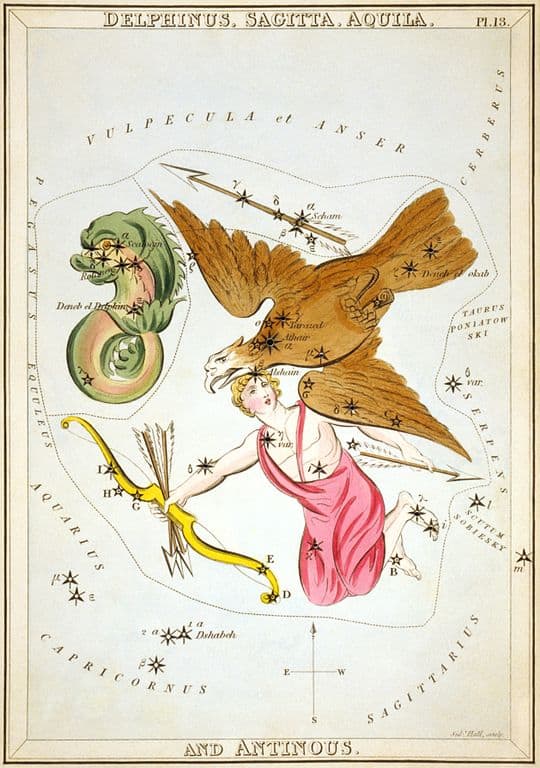
In Greek mythology, the constellation had been associated with Aetos Dios – the eagle that carried the thunderbolts of the supreme god, Zeus.
The eagle was also sent by Zeus to carry the shepherd boy Ganymede, to Mount Olympus. Ganymede is often associated with the constellation of Aquarius.
Location
The constellation of Aquila is the 22nd largest constellation in the sky. Aquila spreads out for over 652 square degrees. The constellation of Aquila is best seen in the northern summer, as it is located along the Milky Way.
Aquila is located in the fourth quadrant (NQ4) in the northern sky, near the celestial equator, and it can be viewed at latitudes between +90o and -70o.
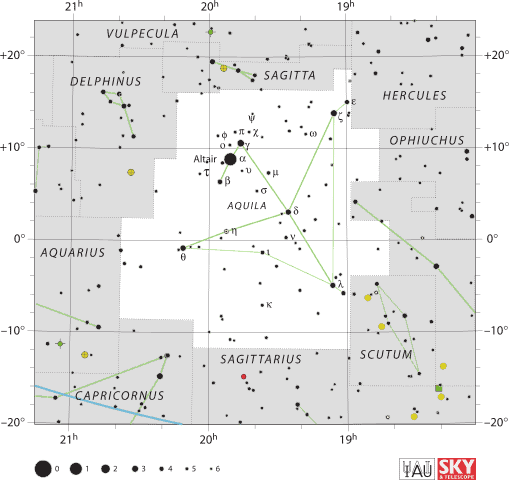
- Right Ascension: 18h 41m – 20h 39m
- Declination: 18.6882229o – 11.8664360o
- Visible: between +90o and -75o
- Best viewed: at 21:00 / 9 p.m. in August
The neighboring constellations around Aquila are Aquarius, Capricornus, Delphinus, Hercules, Ophiuchus, Sagitta, Sagittarius, Scutum, and Serpens Cauda.
Aquila is part of the Hercules family of constellations, together with Ara, Centaurus, Corona Australis, Corvus, Crater, Crux, Cygnus, Hercules, Lupus, Hydra, Lyra, Ophiuchus, Sagitta, Scutum, Serpens, Sextans, Triangulum Australe, and Vulpecula.
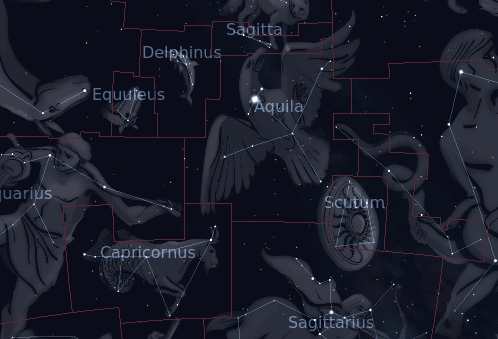
Notable Stars
Around three stars in Aquila are brighter than magnitude 3.00, while two stars are located within 32.6 light-years away from Earth. Aquila currently has 9 stars discovered to host exoplanets.
HD 179079, is a subgiant star with only one planet orbiting it, while HD 183263 has two planets, discovered in 2009. Xi Aquilae, a red clump giant star, known as Libertas, has an exoplanet named Fortitudo.
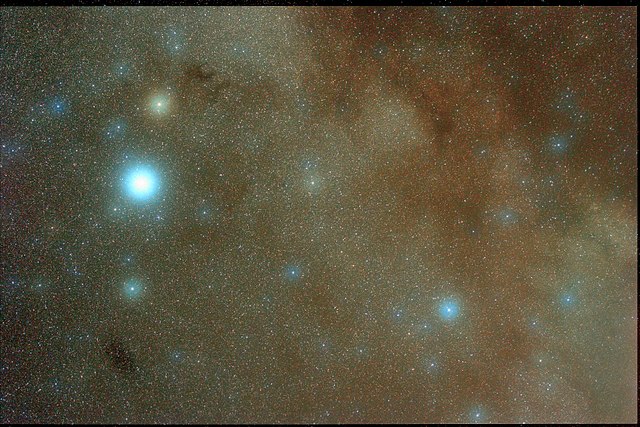
An orange dwarf star, HD 192263, also has a planet, and another star, a yellow subgiant, HD 192699, also has one. Other stars with confirmed exoplanets around them are COROT-10 and COROT-8.
The constellation of Aquila doesn’t have any Messier objects. The brightest star in Aquila is Altair, which is also the 12th brightest in the night sky, having an apparent magnitude of 0.76. The top 10 brightest stars in Aquila are:
Altair
Altair, designated as Alpha Aquilae, is the brightest star in the constellation, being 10.6 times brighter than our Sun. Altair is located at around 16.7 light-years away from us, being one of the three vertices of the Summer Triangle asterism. The other two are Deneb and Vega.
Altair is an A-type main-sequence star, classified as a Delta Scuti variable, displaying variations in brightness over periods that range from 0.8 to 1.5 hours.
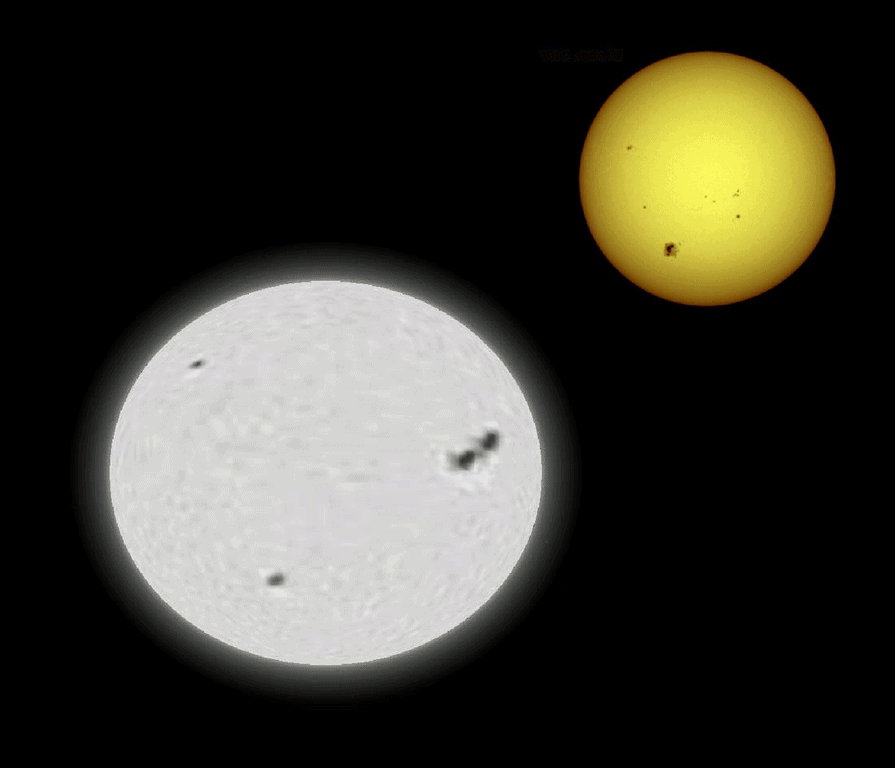
Altair completes one spin around its axis in around 8.9 hours ( our Sun, for comparison, does this in 25 days), having an extreme rotational velocity of around 286 km / 177.7 mi per second.
Altair is 179% more massive than our Sun, having 163% of its radius, and being 1.19 times hotter than our Sun, having surface temperatures of around 6,900 K.
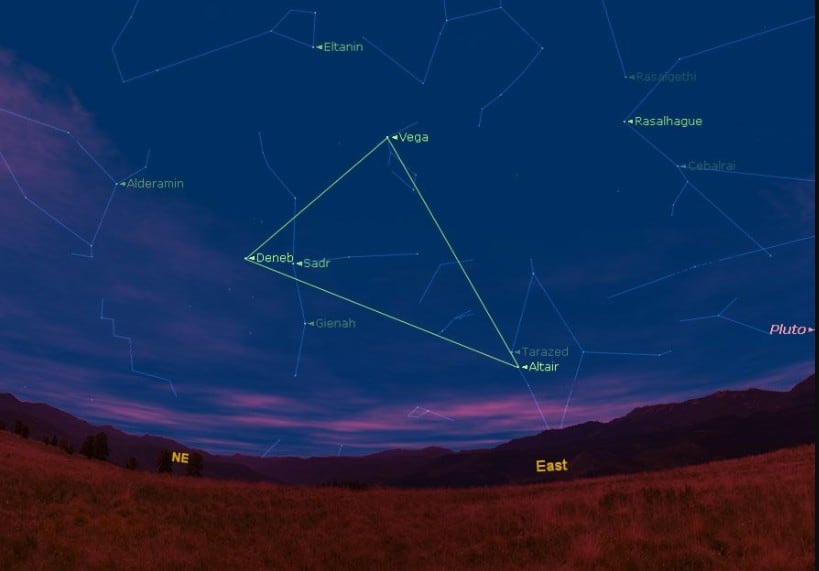
Alshain
Alshain, also designated as Beta Aquilae, is a binary star located at around 44.7 light-years away from us. Alshain is the seventh brightest star in Aquila, having an apparent magnitude of 3.87.
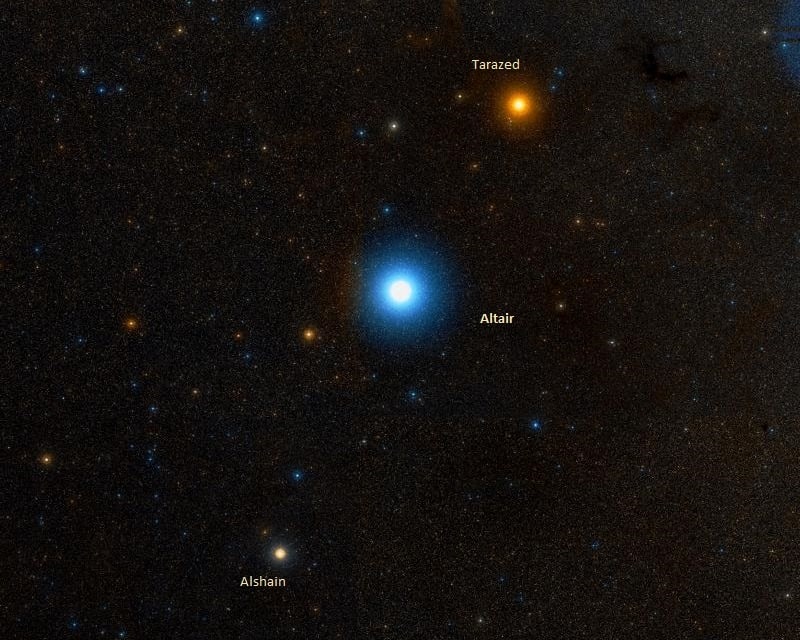
The primary star, Alshain, is a subgiant star that has around 126% of our Sun’s mass, and 328% of its radius. The companion star is a class M red dwarf, located at 13 arcseconds away from the primary. It is very faint, having only 2.5% of our Sun’s luminosity, while Ashain is 6 times brighter than our Sun.
Tarazed
Tarazed, also designated as Gamma Aquilae, is an orange-hued giant star located at around 395 light-years away from us. It is a young star, being only 100 million years old.
Tarazed is the second-brightest star in Aquila, having an apparent magnitude of 2.7, being 2,538 times brighter than our Sun. Tarazed has around 566% of our Sun’s mass, and 9,500% of its radius.
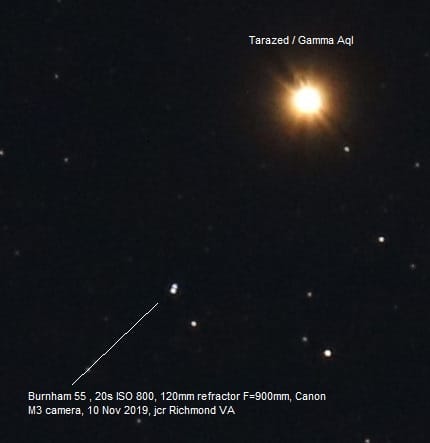
Okab
Okab, designated as Zeta Aquilae, is a spectroscopic binary star, having an apparent magnitude of 2.9, being the third brightest star in Aquila.
Okab is a blue-white main-sequence star that is 39.4 times brighter than our Sun, having 237% of its mass, and around 227% of its radius.
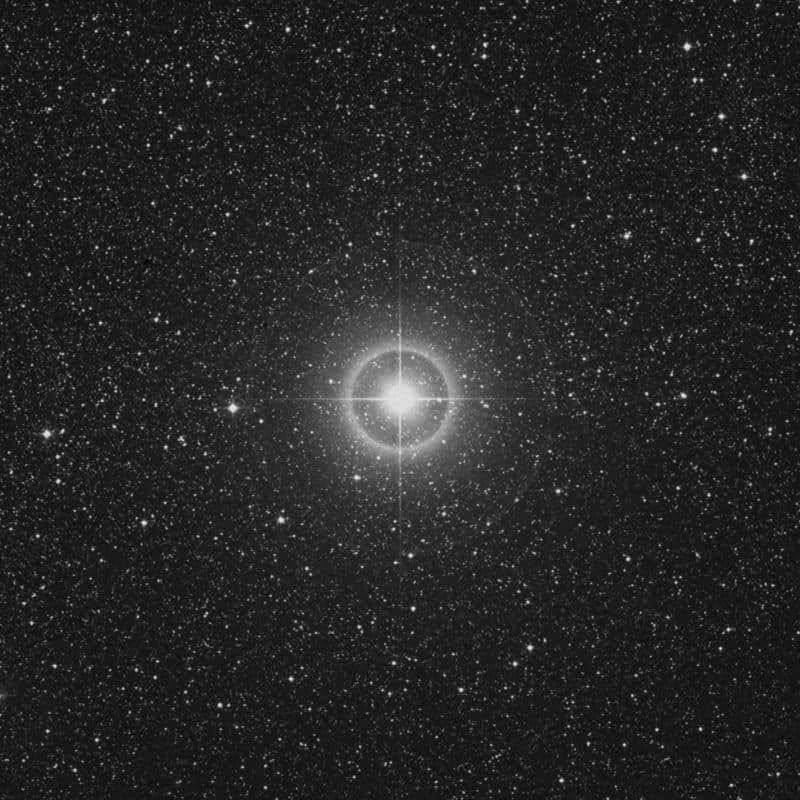
Okab is an exceptionally fast-spinning star, having a rotational velocity of around 317 km / 196.9 mi per second. Because of this, the star’s equatorial radius is 30.7% greater than its polar radius. The star system is located at around 83 light-years away from us.
Eta Aquilae
Eta Aquilae is a multiple star system that was once part of the former Antinous constellation. It is the fifth brightest member of the Aquila constellation, located at around 1,382 light-years away, having an apparent magnitude of 3.87.
Eta Aquilae is also a Cepheid variable star, its magnitude ranges from 3.5 to 4.3 over a period of 7.16 days. Eta Aquilae is 570% more massive than our Sun, having 6,600% of its radius. Eta Aquilae is 2,630 times brighter than our Sun.
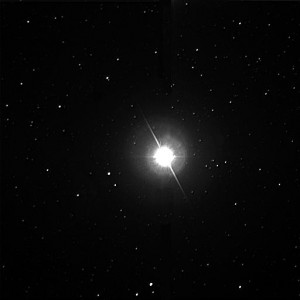
15 Aquilae
15 Aquilae, designated as h Aquilae, is a giant star located at around 289 light-years away from us, having an apparent magnitude of 5.41. 15 Aquilae’s mass is unknown, however, it has around 1,400% of our Sun’s radius.
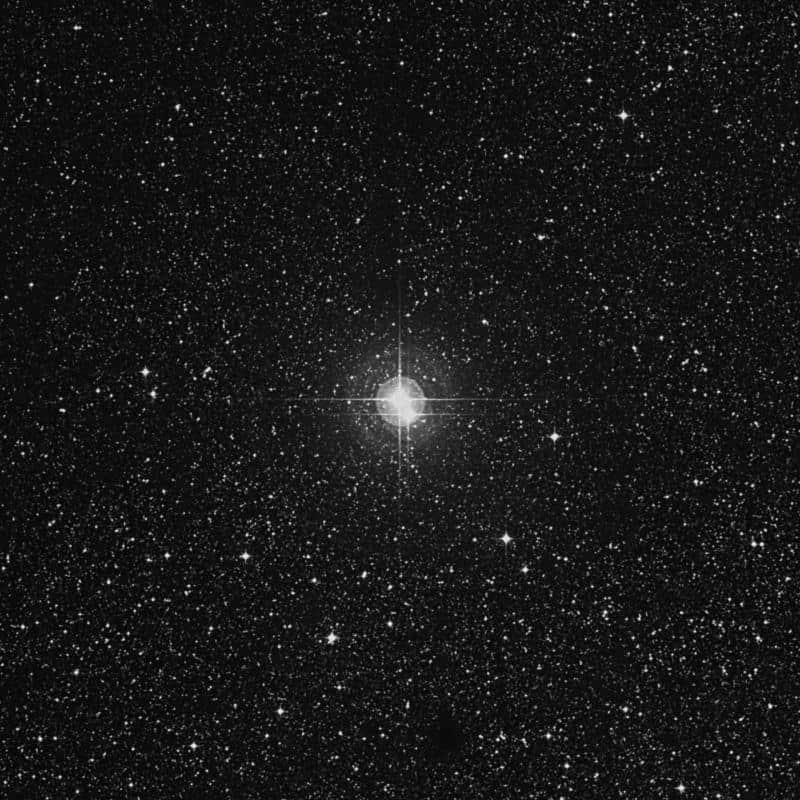
15 Aquilae is also fairly bright, being 83 times brighter than our Sun, yet cooler, with average surface temperatures at around 4,560 K. This star is believed to be part of the thin disk population of the Milky Way.
It is orbiting through the galaxy with an eccentricity of 0.06, which carries it close to the Galactic Core.
57 Aquilae
57 Aquilae is a double star located at around 480 light-years away from us. One of the stars has an apparent magnitude of 6.48, while the other 5.70.
Both stars are massive, B-type main-sequence stars with high rotational velocities. One of them spins at 190 km / 118 mi per second, while the other at 160 km / 99.4 mi per second.
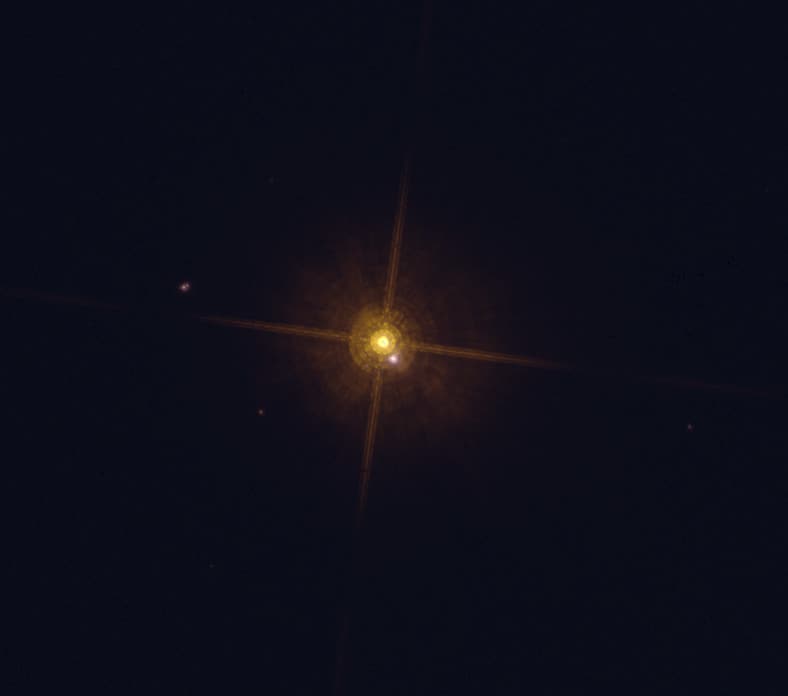
R Aquilae
R Aquilae is a Mira variable type of star, having an apparent magnitude that ranges in brightness from 5.3, down to 12.0, within a period of 269.84 days.
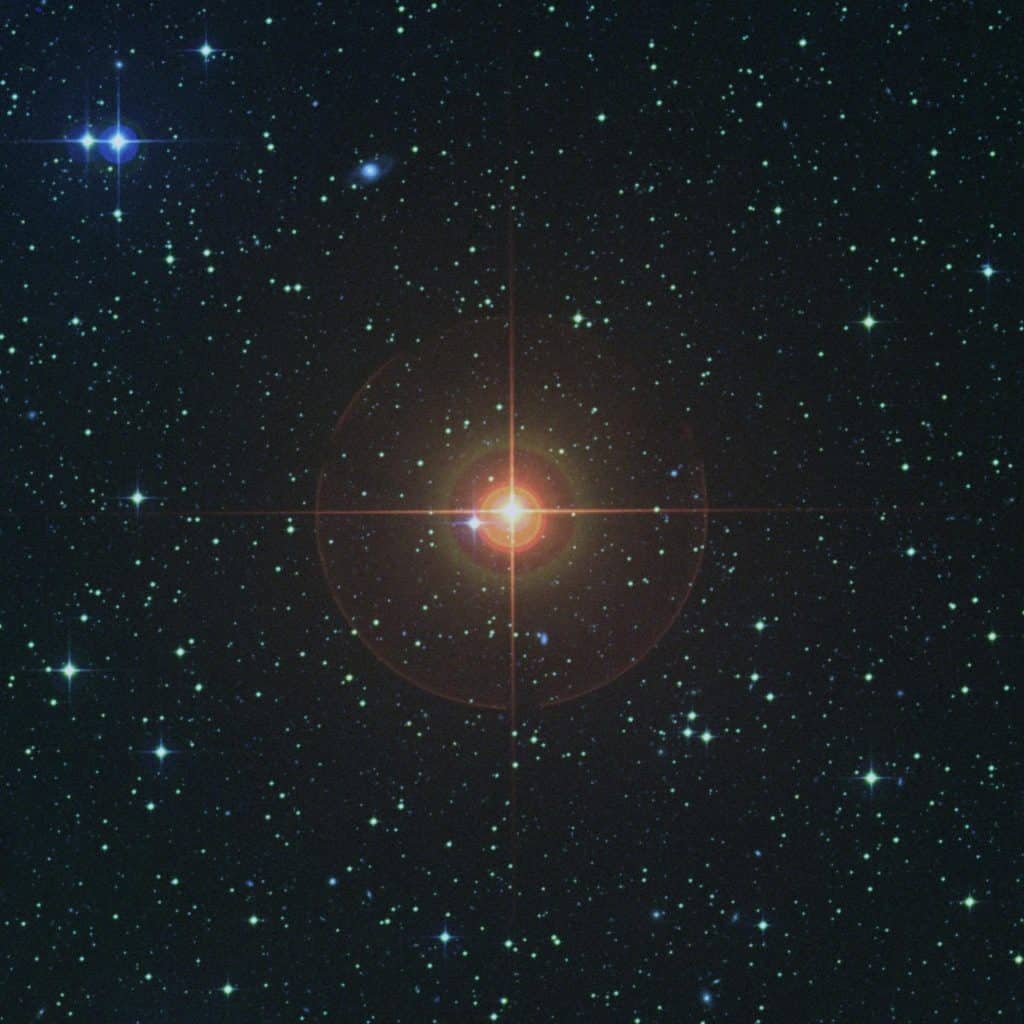
R Aquilae is located at around 780 light-years away from us. It has the same mass as our Sun, however, it is an aging red giant star that has around 25,900 % of our Sun’s radius, being 3,470 times brighter.
FF Aquilae
FF Aquilae is a yellow-white-hued supergiant star located at around 1,350 light-years away from us. This star is a Cephei variable, with its apparent magnitude ranging from 5.18 to 5.51 over a period of 4.47 days.
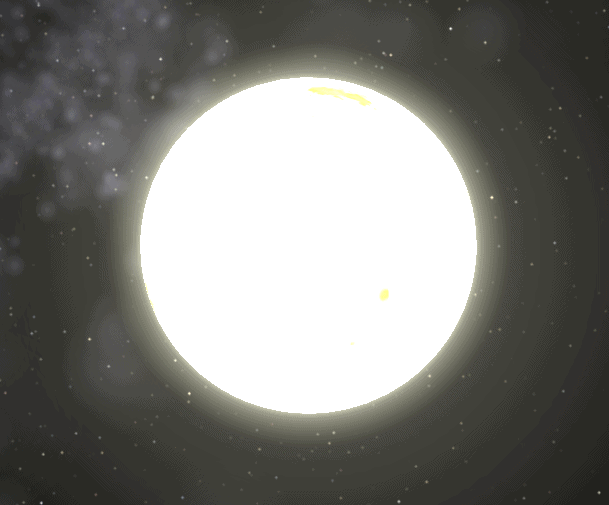
FF Aquilae has around 320% of our Sun’s mass, and 3,900% of its radius. It is much hotter than our Sun, having temperatures of around 6,195 K.
Rho Aquilae
Rho Aquilae is a former star of Aquila. It moved across the border into the neighboring constellation of Delphinus in 1992. Rho Aquilae is a main-sequence star, having an apparent magnitude of 4.94.
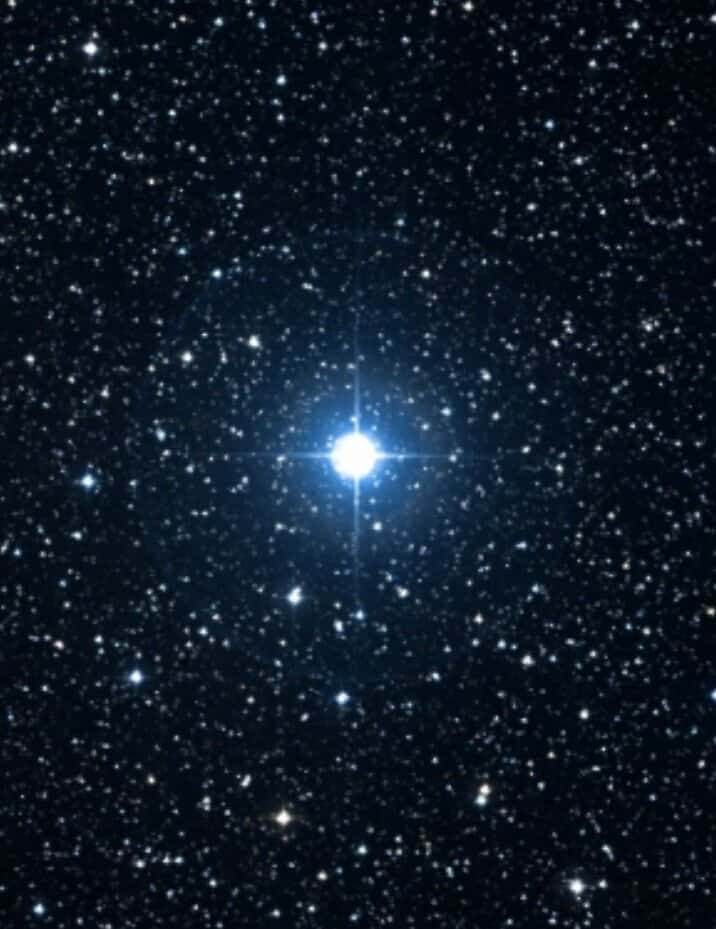
Rho Aquilae is located at around 150 light-years away from us. It is 19.5 times brighter than our Sun, and hotter, having surface temperatures of around 8,804 K.
V Aquilae
V Aquilae is a cool carbon star and a semiregular variable star, located at around 1,300 light-years away from us. V Aquilae has an apparent magnitude of 6.6 – 8.4. Its brightness varies over a period of 400 days.
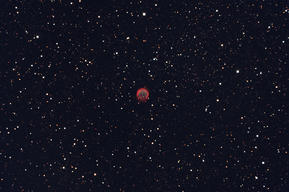
V Aquilae is 6,500 times brighter than our Sun, however, it is more than two times cooler, having temperatures of around 2,800 K. Its spectrum is dominated by strong absorption lines of C2 and CN molecules.
Lambda Aquilae
Lambda Aquilae, also known as Al Thalimain, is the fourth brightest star in Aquila, having an apparent magnitude of 3.43. It is located at around 125 light-years away.
Al Thalimain is a blue/white main-sequence star, that is 310% more massive than our Sun, having 190% of its radius. It is 55 times brighter than our Sun, and around twice as hot.
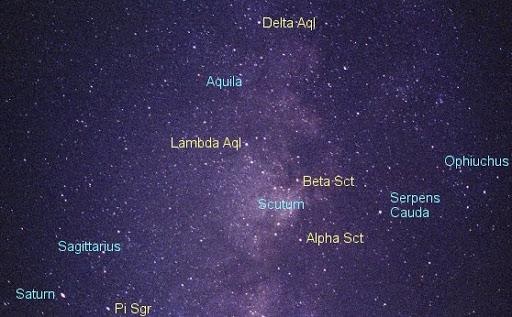
NASA’s Pioneer 11 space probe, which flew by Jupiter and Saturn in the 1970s, is expected to pass near Lambda Aquilae in about 4 million years.
Deep-Sky Objects
There are several interesting deep-sky objects in Aquila, among them, the planetary nebulae NGC 6781, the Glowing Eye Nebula, NGC 6778, the Phantom Streak Nebula, or the open clusters NGC 6709, NGC 6755, or globular cluster NGC 6760.
An extragalactic object is also present in Aquila, the Hercules-Corona Borealis Great Wall – which may be the largest single mass concentration of galaxies known in the Universe.
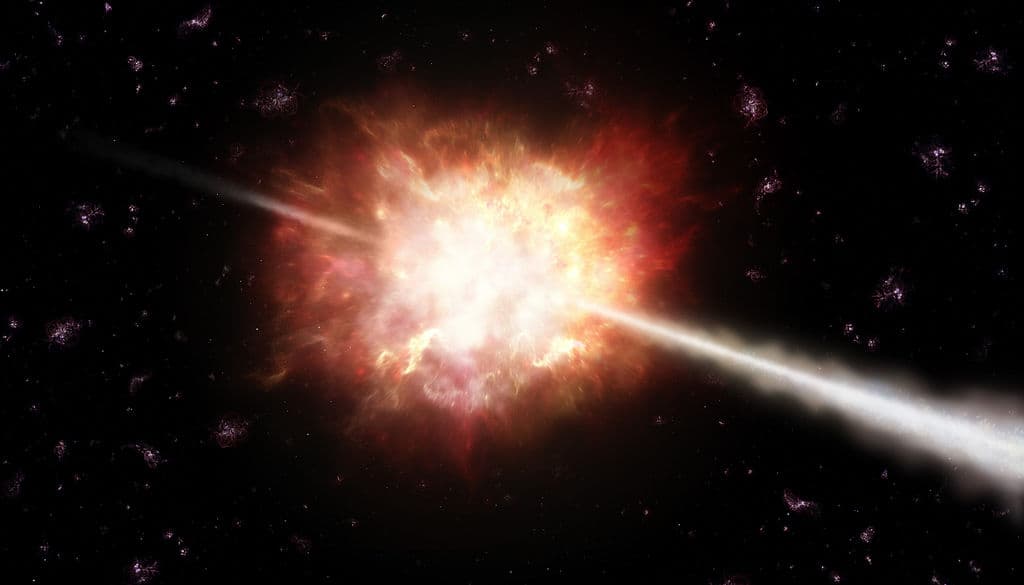
It has the size of around 10 billion light-years ( the observable universe is just 93 billion light-years in diameter). This structure lies in the NQ2, NQ3, and NQ4 galactic quadrants of the sky, in the northern hemisphere.
Many dispute the existence of this structure since it contradicts many established physical theories, however, it remains to be seen soon if its existence will finally be proven or disproven.
Planetary Nebula
NGC 6781
NGC 6781 is a planetary nebula that shows some resemblance to the Owl Nebula, located in the constellation of Ursa Major. It has an apparent magnitude of 11.4, and an apparent linear diameter of around 2 light-years.
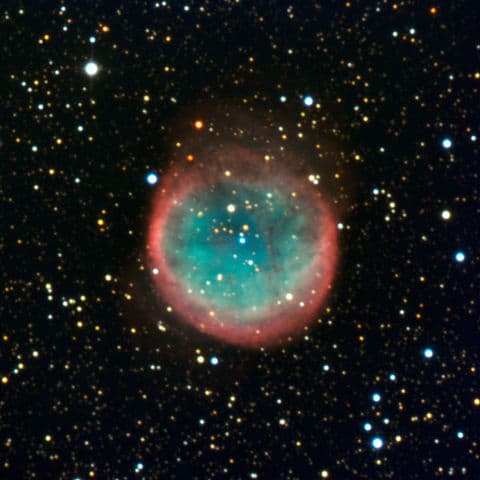
Glowing Eye Nebula
The Glowing Eye Nebula, designated as NGC 6751, and also known as the Dandelion Puffball Nebula, is a planetary nebula estimated to be 0.8 light-years in diameter.
The Glowing Eye Nebula is located at around 6,500 light-years away, having an apparent magnitude of 11.9. The star at the center of the nebula has a surface temperature of around 140,000 K, or 24.2 times hotter than our Sun.
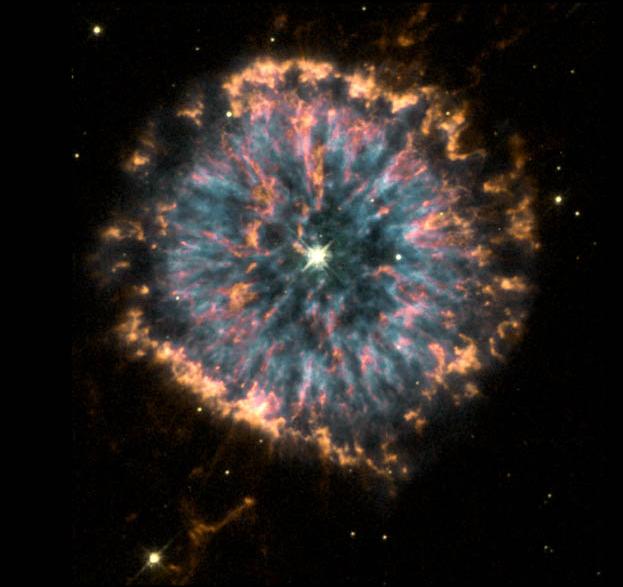
The nebula itself formed when a star collapsed and threw off its outer layer of gas thousands of years ago. This nebula is an easy telescopic target for deep-sky observers since it is located in the southeast of the extremely colored cool carbon star V Aquilae.
NGC 6778
NGC 6778 is a planetary nebula located at around 10,300 light-years away from us. It has an apparent magnitude of 11.9, being around 4,400 years old.
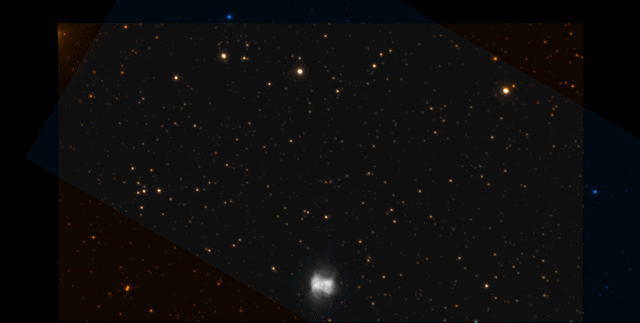
Phantom Streak Nebula
The Phantom Streak Nebula, designated as NGC 6741, is a planetary nebula located at around 7,000 light-years away from us. It has an apparent magnitude of 11, being 0.1 arc minutes in diameter, and fairly bright.
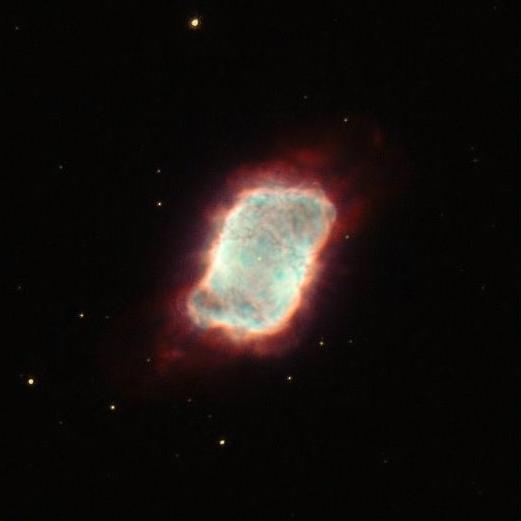
E Nebula
The E Nebula, also known as Barnard’s E Nebula, consists of two dark nebulae, Barnard 142, and 143 respectively. They are located at 1.5o west of Tarazed, Gamma Aquilae. The E Nebula is 0.5o across, roughly the size of the full Moon. It is located at around 2,000 light-years away from us.
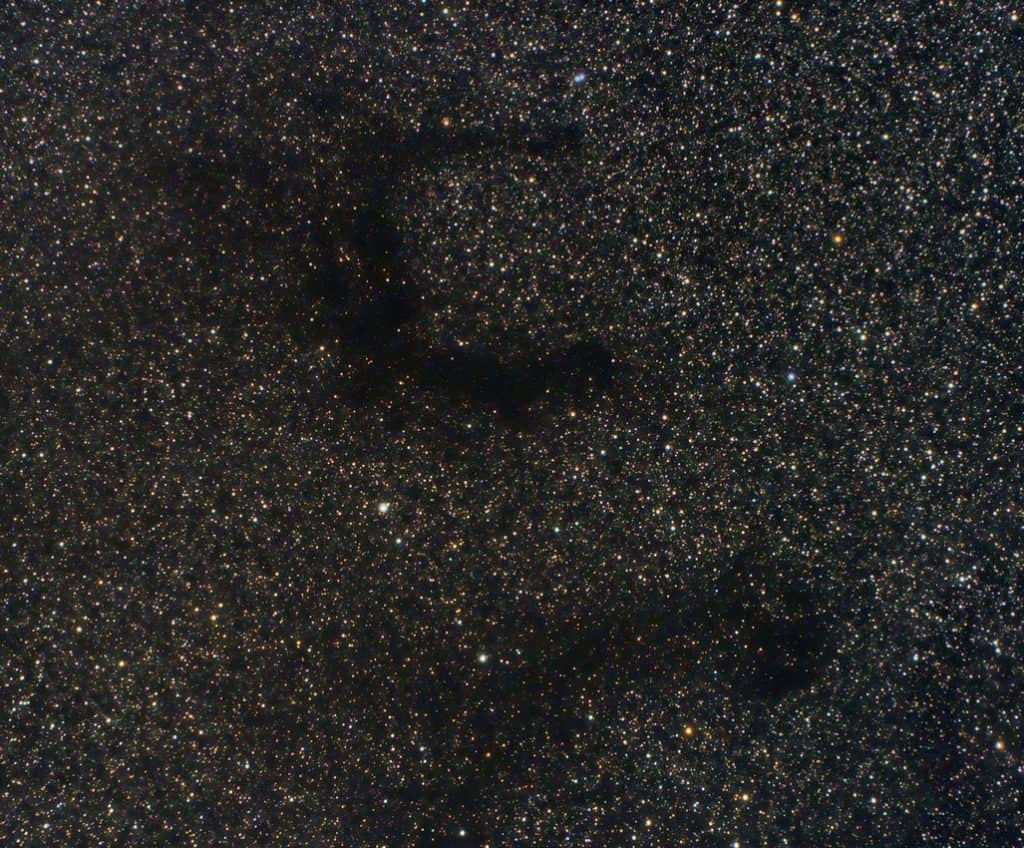
Clusters
NGC 6709
NGC 6709 is a loose open cluster that contains around 40 stars, which range in magnitude from 9 to 11. This open cluster is situated at around 3,504 light-years away from us.
NGC 6709 has an overall magnitude of 6.7, it can easily be resolved in small telescopes. NGC 6709 lies five degrees southwest of Zeta Aquilae.
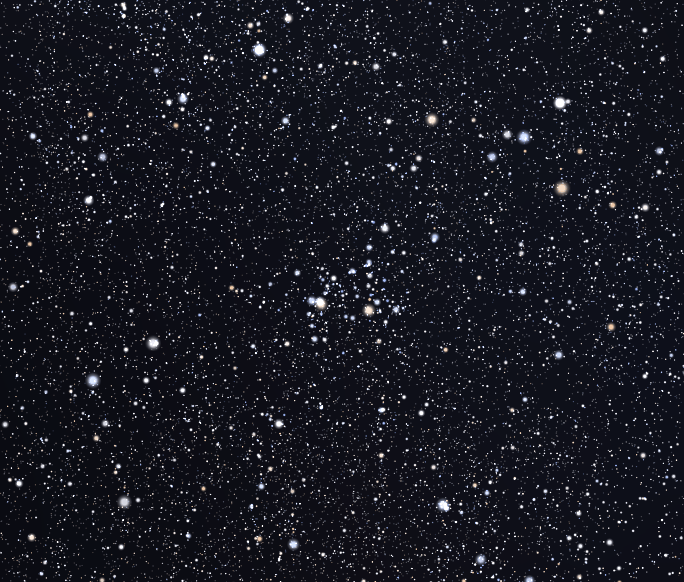
NGC 6755
NGC 6755 is an open cluster situated at around 4,632 light-years away from us. It has an overall apparent magnitude of 7.5, being 15’ in size.
NGC 6755 contains many stars, the brightest of which are of magnitude 12th and 13th. This cluster can be seen 4.5o west of the star Delta Aquilae.
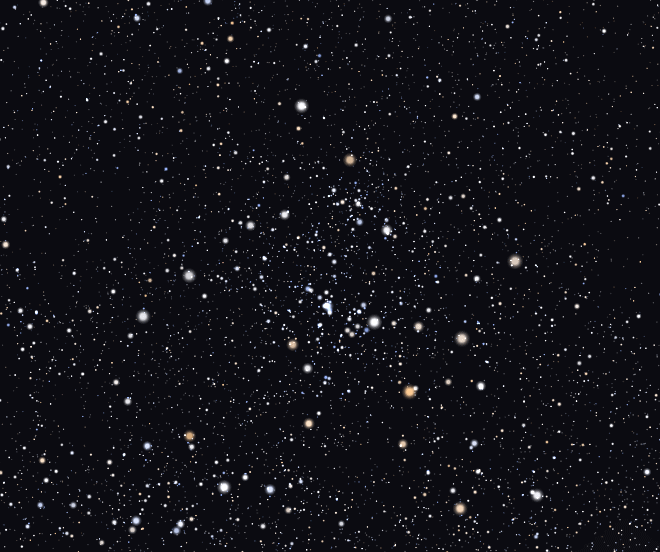
NGC 6760
NGC 6760 is a globular cluster located at around 24,100 light-years away from us. It has an apparent magnitude of 9.0 and an apparent size of 9.6’.
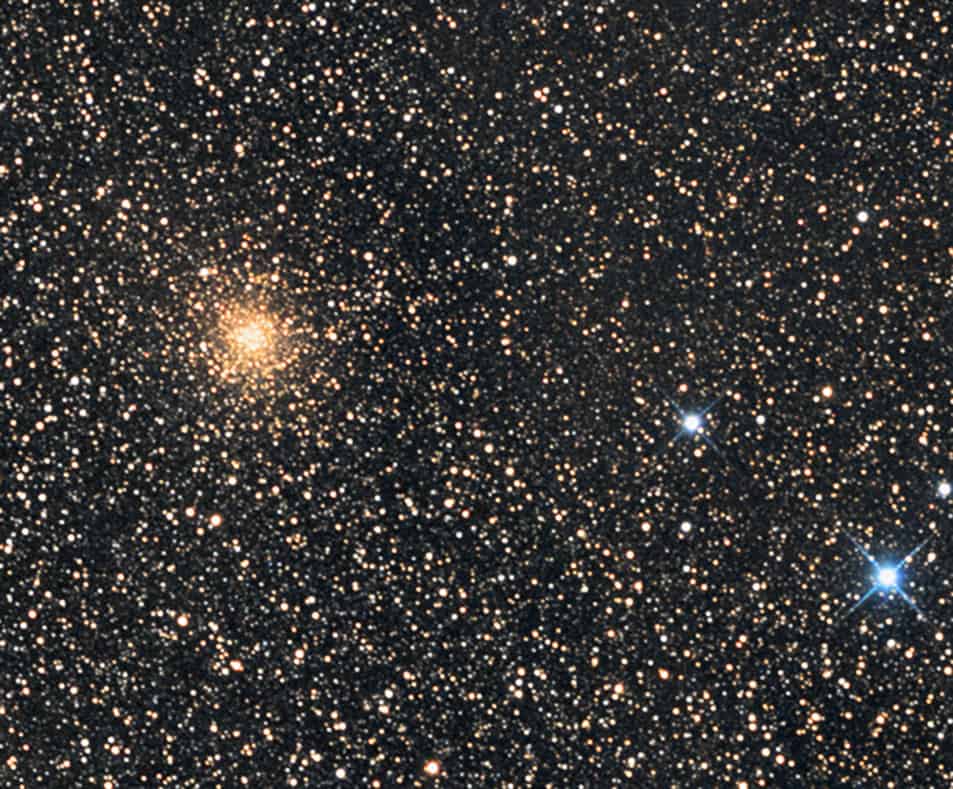
Meteor Showers
There are two meteor showers whose radiant appear to be from Aquila. They are the June Aquilids, and the Epsilon Aquilids.
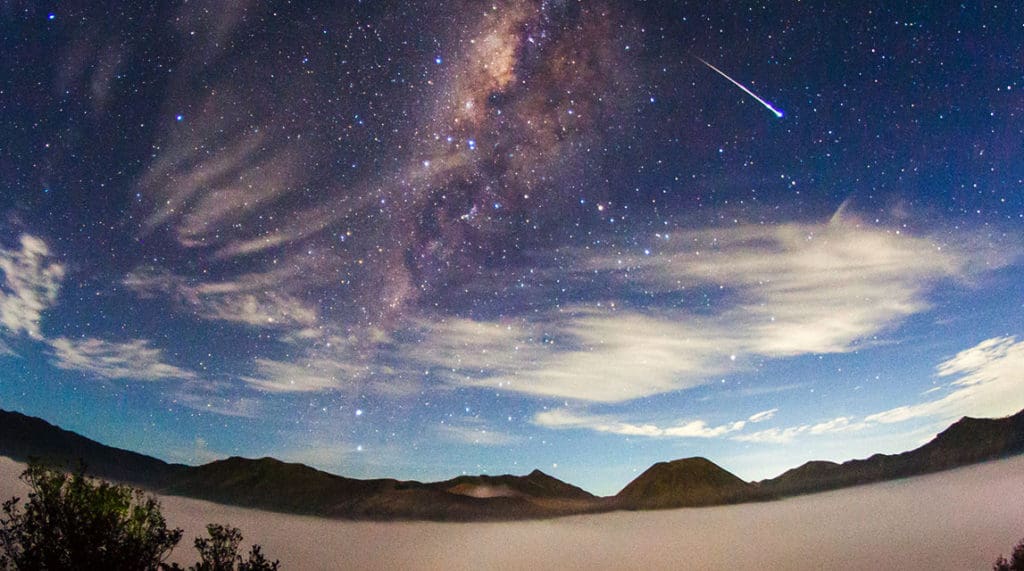
Did you know?
- In Hinduism, the constellation of Aquila is associated with the half-eagle half-human deity Garuda.
- In ancient Egypt, Aquila was possibly viewed as the falcon of Horus.
- In Hawaii, Altair was called Humu – “to sew, to bind together parts of a fishhook”.
- In the Marquesas Islands, Aquila was known as Pao-toa – Fatigued Warrior.
- The Greek Aquila is most likely based on the Babylonian constellation of the Eagle.
- The Koori aboriginal people of Australia knew Altair as Bunjil – a wedge-tailed eagle who had the other 2 brightest stars in Aquila as his wives.
Sources:
Image Sources:
- https://upload.wikimedia.org/wikipedia/commons/thumb/e/ea/Sidney_Hall_-_Urania%27s_Mirror_-_Delphinus%2C_Sagitta%2C_Aquila%2C_and_Antinous.jpg/540px-Sidney_Hall_-_Urania%27s_Mirror_-_Delphinus%2C_Sagitta%2C_Aquila%2C_and_Antinous.jpg
- https://upload.wikimedia.org/wikipedia/commons/thumb/f/fb/Aquila_IAU.svg/509px-Aquila_IAU.svg.png
- https://in-the-sky.org/images/constellations/con_AQL_000.png
- https://upload.wikimedia.org/wikipedia/commons/thumb/1/1a/Altair%2C_Tarazed_and_Alshain.jpg/640px-Altair%2C_Tarazed_and_Alshain.jpg
- https://upload.wikimedia.org/wikipedia/commons/thumb/7/7f/Altair-Sun_comparison.png/895px-Altair-Sun_comparison.png
- https://earthsky.org/upl/2017/06/Screen-Shot-2018-06-04-at-1.55.18-PM-e1528134961914.png
- https://www.star-facts.com/wp-content/uploads/2019/09/Altair-Tarazed-and-Alshain.jpg?189db0&189db0
- https://www.cloudynights.com/uploads/monthly_11_2019/post-57336-0-37178900-1573462506.jpg
- https://theskylive.com/sky/stars/star-images/72/7235_800.jpg
- https://www.constellation-guide.com/wp-content/uploads/2011/01/Altair-Alpha-Aquilae-300×300.jpg
- https://theskylive.com/sky/stars/star-images/72/7225_800.jpg
- https://upload.wikimedia.org/wikipedia/commons/b/bf/W_Aquilae_binary.jpg
- https://cdn.mos.cms.futurecdn.net/xzS9jWYkggcxXdwDzoTVD3.jpg
- https://vignette.wikia.nocookie.net/list-of-stars/images/7/7d/F-0.PNG/revision/latest?cb=20180427073013
- https://pbs.twimg.com/media/DK6fQIdXkAAQBnf.jpg
- https://www.sciencesource.com/Doc/TR7/a/9/c/9/SS2388571.jpg?d63642071103
- https://lh3.googleusercontent.com/proxy/pOt_FLOq1WVNxxa5tMT05noyNu2mOWUFHL79rK0M9fXFyyQKWbLpyu1oK234ZANdLCeK2Uur0D1JzPXNmrpLsKfQD85Rft3-
- https://upload.wikimedia.org/wikipedia/commons/thumb/f/f8/Most_distant_Gamma-ray_burst.jpg/1024px-Most_distant_Gamma-ray_burst.jpg
- https://upload.wikimedia.org/wikipedia/commons/thumb/6/69/NGC-6781.jpg/480px-NGC-6781.jpg
- https://upload.wikimedia.org/wikipedia/commons/c/c0/NGC6751.jpg
- https://upload.wikimedia.org/wikipedia/commons/thumb/8/85/NGC_6778_-_VLT%28FORS2%29_-_ROIIIBOIII3000.png/640px-NGC_6778_-_VLT%28FORS2%29_-_ROIIIBOIII3000.png
- https://www.constellation-guide.com/wp-content/uploads/2011/01/Phantom-Streak-Nebula-NGC-6741.jpg
- https://upload.wikimedia.org/wikipedia/commons/9/9e/ENebulaHunterWilson.jpg
- https://upload.wikimedia.org/wikipedia/commons/8/8d/NGC_6709_large.png
- https://upload.wikimedia.org/wikipedia/commons/5/51/NGC_6755.png
- https://www.greggsastronomy.com/IMAGES/ngc6760_LRGBcrop.jpg
- https://www.amsmeteors.org/wp-content/uploads/2018/06/featured-3.jpg
